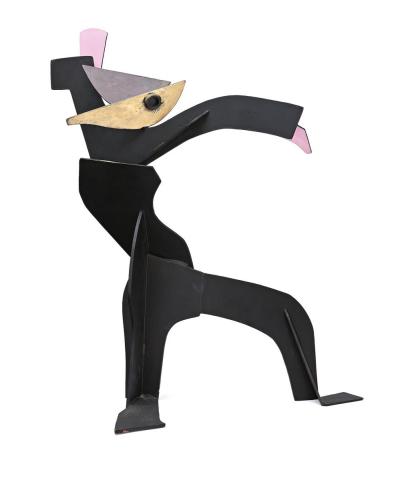DERVISH (MAQUETTE II), 1991
INGE KING
polychrome steel
70.0 cm height
Australian Galleries, Melbourne
The Estate of the late James O. Fairfax AC, New South Wales, acquired from the above in 1991
Joie De Vivre: An Exhibition of Recent Sculptures by Inge King, Australian Galleries, Melbourne, September – October 1991
Dervish, 1991, painted bronze, 167.0 x 132.0 x 100.0 cm, exhibited in Inge King: Large and Small Bronze Sculptures, Australian Galleries, Melbourne, 26 April – 22 May 1993
Teetering precariously with joyful and flamboyant expression, Inge King’s second maquette of Dervish is imbued with a sense of movement that contradicts the solidity of its assemblage. Although directly descended from her geometric totemic sculptures, King’s dancing silhouettes were the most figurative artworks of her later career. They retained the planar quality of her abstract works, becoming three-dimensional collages of sheet metal. Inspired by Henri Matisse’s iconic decoupages,1 Dervish and its accompanying dancers interact with the space around them – the intersecting planes of their construction playing with depth and shadow, extending their outermost limits beyond the physical boundaries that confine them. The surprising addition of small elements of colour assisted the creation of ‘not only significance and shape, but also extremity, distance, and advancing and receding planes’.2
While the seventies and eighties were characterised by the realisation of King’s abstract maquettes into large scale public sculptures, the decade that followed showed a radical reframing of the artist’s vision: smaller, autonomous objects, introduction of colour and clearer representational forms. Perhaps a product of her confidence as a mature sculptor, this new direction was joyful and showed a greater connection to her European artistic heritage. King was not alone in adopting a more figurative and object-based approach to sculpture in the latter half of the eighties, as Maudie Palmer noted in her review of Australian Sculpture Now, the Second Australian Sculpture Triennial at the National Gallery of Victoria in the summer of 1984 – 85.3
James Fairfax acquired this maquette from the Joie de Vivre solo exhibition the artist held at Australian Galleries in Sydney, complementing her larger sculpture he already had installed in the gardens at Retford Park. Celebrating the joy of life, the sculptures of this exhibition synthesised human movement into single stylised static pose, embodying the pregnant moment, theorised by 18th century philosopher Gotthold Lessing, linking form to a temporal background. While the dancers are stylised, they are not idealised. The awkward poses they adopt evoke the recognisable movements of human expression, both performative and anodyne. King has also attempted to introduce a further sensory element – sound. Poised to stamp his foot on the ground, the dervish is suspended in action, his centre of gravity dangerously off-kilter. Critics at the time applauded the grace, ease and gaiety of the works in the exhibition at Australian Galleries, one even noted their musicality. King herself considered Joie de Vivre to have been her most important exhibition. 4
1. Inge King had a print of Henri Matisse’s Icarus hanging in her house.
2. Trimble, J., Inge King. Sculptor, Art and Australia and Craftsman House, Sydney, 1996, p. 141
3. Palmer, M., quoted in Trimble, J., op cit., p. 143
4. Trimble, J., op cit., pp. 148 – 149
LUCIE REEVES-SMITH
Sydney Gallery Manager
Deutscher and Hackett
